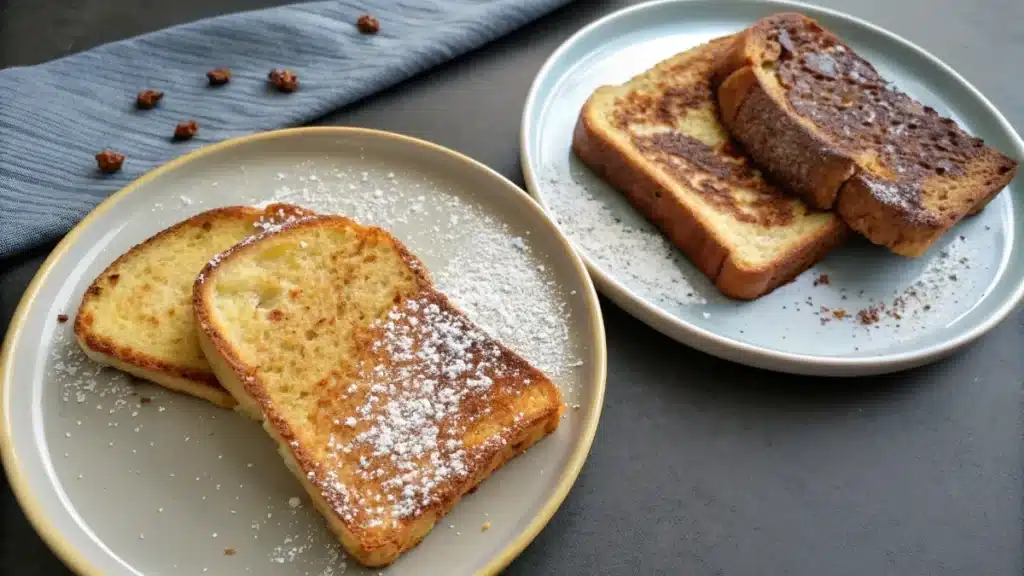Sourdough French Toast Bake: The Perfect Brunch Casserole You Didn’t Know You Needed
When weekend mornings call for something indulgent, easy, and crowd-pleasing, few dishes rise to the occasion like a sourdough French toast bake. This brunch favorite combines the tangy goodness of sourdough bread with a rich custard soak, baked to golden perfection. It’s cozy, satisfying, and surprisingly simple to prepare. Whether you’re hosting brunch, meal prepping for the week, or just want a warm breakfast without standing over the stove, this baked version of French toast has you covered.
In this article, we’ll break down everything you need to know to make the ultimate sourdough French toast casserole—from bread selection to baking tips, flavor variations, and how to avoid common pitfalls like sogginess. You’ll also discover how sourdough stacks up against other types of bread, and we’ll answer some of the web’s most asked questions to ensure your bake is perfect every time.
Check out our Sourdough French Toast for a stovetop version that inspired this casserole twist!
Table of Contents
Why Sourdough Is a Game-Changer for French Toast Bake
The Science of Sourdough: Flavor, Texture, and Structure
Sourdough bread, made through natural fermentation, has a distinctive tangy flavor and chewy crust that sets it apart from enriched breads like brioche or challah. This unique structure makes it ideal for soaking in a custard base without falling apart. The open crumb (those irregular holes) allows the egg mixture to seep in and flavor each bite thoroughly, while the crust develops a beautiful crispness when baked.
- Texture Advantage: Its thicker crust and chewy crumb maintain structure even after absorbing liquid, preventing the dreaded soggy middle.
- Flavor Depth: The natural acidity in sourdough balances the richness of cream and eggs, giving each bite a well-rounded taste.
- Absorption Power: Thanks to its porous structure, sourdough soaks up custard evenly, giving you consistent flavor throughout.
Comparing Sourdough with Brioche, Challah, and White Bread
Let’s stack it up:
| Bread Type | Texture | Flavor Profile | Best Use In Bake |
|---|---|---|---|
| Sourdough | Chewy, crusty | Tangy, fermented | Bold, hearty bakes |
| Brioche | Soft, airy | Buttery, sweet | Rich & sweet casseroles |
| Challah | Fluffy, tender | Mild, eggy | Great for custard-based dishes |
| White Bread | Soft, basic | Neutral | Lacks structure; gets mushy |
Why sourdough wins: If you’re after a brunch casserole that holds its shape, delivers deep flavor, and can handle heavy toppings like fruit or nuts, sourdough bread outperforms softer breads that collapse under pressure.
Discover great ideas like this Delicious Brioche French Toast Casserole if you’re leaning toward a softer, sweeter base.
Ingredients That Elevate Your Sourdough French Toast Bake
Choosing the Right Sourdough Loaf: Fresh vs. Day-Old
When making a sourdough French toast bake, bread choice isn’t just about taste—it’s about texture and moisture control. The number one tip? Use day-old or slightly stale sourdough. Why?
- Better Absorption: Drier sourdough acts like a sponge, soaking up the rich custard without falling apart.
- Improved Texture: Fresh bread tends to break down quickly, leading to a mushy base, while slightly stale sourdough gives you a chewy bite with a crisp top.
- More Flavor: Letting the loaf age deepens sourdough’s tangy profile, adding bold character to your final bake.
Pro Tip: If your loaf is too fresh, slice it and leave it out overnight to dry—or toast it briefly in the oven at 275°F for 8–10 minutes before assembling your bake.
Must-Have Custard Ingredients for Rich and Creamy Texture
The custard mixture is the heart of any baked French toast. With sourdough bread, you need a mix that’s rich enough to soften the crumb without overpowering the bread’s natural flavor.
Here’s what your base should include:

| Ingredient | Why It Matters |
|---|---|
| Eggs | The protein binds the custard to the bread |
| Whole Milk | Adds creaminess without heaviness |
| Heavy Cream | For that luxurious texture and rich mouthfeel |
| Vanilla Extract | Adds a warm, sweet background note |
| Cinnamon | Balances the sourdough tang with cozy spice |
| Maple Syrup or Brown Sugar | Adds sweetness and caramel undertones |
You can also experiment with flavors like:
- Nutmeg: for a holiday-style taste
- Orange zest: for a refreshing citrus twist
- Almond extract: adds depth and a nutty finish
Don’t miss our Sourdough Apple Fritter Bread for another delicious way to blend sweet flavors with sourdough.
Bonus Additions for Customization
Want to make it your own? Add-ins like the following elevate your bake:
- Chopped nuts (pecans, walnuts)
- Fresh or frozen berries
- Cream cheese dollops
- Toasted coconut or chocolate chips
These not only add flavor and texture but also visual appeal when serving.
Looking for inspiration? Try our Sourdough Breakfast Recipes to pair with your casserole or mix into your brunch table lineup.
Step-by-Step Guide to Making the Best Sourdough French Toast Bake
Creating a flawless sourdough French toast bake doesn’t require culinary expertise—it’s all about smart prep and timing. Here’s a practical, step-by-step guide you can follow whether you’re making breakfast for two or a crowd-pleasing holiday brunch.
Prepping the Sourdough and Assembling the Layers
Before diving into mixing and baking, let’s prep the bread—the star of the show.
Step 1: Slice and Cube Your Bread
- Use day-old sourdough, sliced into 1-inch cubes.
- Remove the crust if you prefer a softer interior; keep it on for a crunchier texture.
Step 2: Grease Your Baking Dish
- Use a 9×13-inch pan, lightly greased with butter or cooking spray.
- For extra flavor, sprinkle a thin layer of brown sugar on the base.
Step 3: Layer Like a Pro
- Start with half the bread cubes.
- Pour half of your custard mixture over the bread.
- Add your toppings (berries, nuts, etc.).
- Continue layering the rest of the bread and custard to ensure an even, well-soaked consistency throughout.
Pro Tip: Press the bread gently with the back of a spatula to ensure it fully absorbs the liquid. This creates a rich, moist base with a golden top.
Soaking Time and Baking Instructions for Optimal Results
Getting the texture right starts with soaking and ends in the oven.
Step 4: Chill for Maximum Flavor
Let the assembled bake rest:
- Minimum: 30 minutes on the counter
- Best: Overnight in the fridge, covered with plastic wrap
This resting time allows the custard to penetrate each bread cube, making for an evenly flavored and soft bake.
Step 5: Bake to Perfection
- Preheat oven to 350°F (175°C).
- Bake uncovered for 40–45 minutes, or until the top is golden brown and the center is set (a toothpick should come out clean).
| Doneness Test | How to Know |
|---|---|
| Underbaked | Liquid bubbles at the edges, soggy center |
| Perfect | Slightly crisp top, firm center, moist inside |
| Overbaked | Dry corners, crust too dark, dense texture |
Optional Finish:
- Broil the top for 1–2 minutes at the end if you love a crispy crust.
- Sprinkle powdered sugar on top just before serving to add a touch of sweetness and visual appeal.
Serve warm, straight from the dish, or let cool slightly for cleaner slices. Either way, it’s comfort food at its finest.
Don’t miss our French Toast Bagel for a unique twist on the classic flavors—bagel lovers rejoice!
Sourdough vs. Other Breads in French Toast Bake
One of the most common questions for any French toast casserole lover is: what bread works best? While brioche and challah often steal the spotlight, sourdough bread brings something extra—flavor complexity, texture resilience, and a rustic edge. Let’s explore how it stacks up against the rest.
Why Sourdough Works Better Than Soft Sandwich Bread
While white sandwich bread is soft and absorbent, it often falls short in baked casseroles. Here’s why sourdough French toast bake wins:
- Structure & Integrity:
Sandwich bread turns mushy under custard. Sourdough’s dense crumb and chewy crust hold shape, even after soaking overnight. - Bold Flavor:
Soft breads are mild and sometimes bland. Sourdough has a slightly sour tang that complements sweet ingredients like maple syrup, cinnamon, and fruit. - Crust Power:
Sourdough’s thick outer crust adds a wonderful contrast—a crispy, golden layer that white bread can’t replicate. - Better Absorption:
With its natural pores, sourdough absorbs just the right amount of custard without collapsing.
| Feature | Sourdough | Soft White Bread |
|---|---|---|
| Texture | Chewy and crusty | Soft and sponge-like |
| Flavor Profile | Tangy and hearty | Neutral and mild |
| Absorbs Custard | Evenly and slowly | Quickly and unevenly |
| Final Bake Quality | Crisp top, tender base | Often soggy or collapsed |
In short: If you want your French toast bake to feel like a warm, rustic bakery creation instead of a limp loaf soaked in egg, sourdough is your go-to.
What Makes Sourdough Uniquely Suited for Baked Casseroles
Beyond breakfast, sourdough shines in baked dishes for these reasons:
- Acidity helps balance the richness of custard and sugar, adding complexity without overpowering sweetness.
- Long fermentation naturally enhances digestibility, especially for those sensitive to gluten.
- Hearty character: Sourdough pairs well with savory and sweet elements, making it versatile for add-ins like cream cheese, nuts, or bacon.
Even though brioche may be softer and more luxurious, it can overwhelm with sweetness. Challah is pillowy and elegant, but sometimes too delicate for longer baking times. Sourdough hits the sweet spot—strong, flavorful, and endlessly adaptable.
Learn more about how sourdough transforms other brunch dishes in our Gluten-Free Sourdough Bread article—it’s a great read if you’re experimenting with dietary alternatives.
Avoiding Common Mistakes in French Toast Casseroles

So, you’ve prepped the perfect sourdough cubes, soaked them in a rich custard, and baked your casserole—only to pull out a soggy, underwhelming mess. It happens. But with the right tips, you can avoid the most common pitfalls and master a foolproof sourdough French toast bake every time.
Why Is My French Toast Bake Soggy? Troubleshooting Tips
A soggy center is the most frequent complaint with baked French toast, especially when using thick-cut bread like sourdough. Here’s what might be going wrong—and how to fix it.
1. Bread Was Too Fresh
Fresh sourdough is too moist and soft to absorb custard properly. Always use stale or toasted bread.
Fix: Cube the bread and let it sit out overnight or lightly toast in the oven for 8–10 minutes.
2. Too Much Custard
If your custard-to-bread ratio is too high, the bread will float and stay wet inside.
Fix: Use about 1 ½ to 1 ¾ cups of liquid for every 4 cups of bread cubes.
3. Not Enough Resting Time
Rushing the soak time results in uneven distribution. The top gets dry while the bottom gets soggy.
Fix: Chill the assembled casserole for at least 4 hours (overnight is best).
4. Underbaking
If the center is still jiggly when removed from the oven, it hasn’t set.
Fix: Bake uncovered at 350°F for 45 minutes, or until a knife inserted in the center comes out clean.
How to Avoid Overbaking or Underbaking the Dish
Just as sogginess ruins a bake, so does dryness. Striking the right balance between moist and firm is crucial.
| Problem | What Causes It | Solution |
|---|---|---|
| Underdone | Oven too hot or short baking time | Bake longer at 350°F |
| Overdone | High heat, thin layer of custard | Cover with foil after browning |
| Dry Bake | Not enough custard or over-soaking | Use precise measurements |
Pro Tip: For extra insurance, tent the dish with foil after 30 minutes of baking. This prevents the top from burning before the center is fully cooked.
Additional Mistake-Proofing Hacks
- Always grease your dish to avoid sticking.
- Don’t skip the rest after baking: Let the dish cool for 10–15 minutes before slicing. It sets better and slices cleaner.
- Want crispy edges? Use a metal pan instead of glass.
Even the most experienced home cooks run into issues with baked French toast, but a little planning and these simple adjustments make all the difference.
Check out our Cottage Cheese Banana Bread for another satisfying and protein-rich breakfast bake.
Flavor Variations and Add-Ins to Spice It Up
Once you’ve mastered the classic version of sourdough French toast bake, the real fun begins—customizing it with creative twists. Whether you lean sweet or savory, sourdough’s bold personality pairs beautifully with dozens of ingredients.
Sweet Options: Cinnamon Swirl, Apple, and Brown Sugar
Want to give your bake a cozy, dessert-like twist? Here are some irresistible sweet variations that work especially well with sourdough’s tangy bite:
1. Cinnamon Swirl Delight
- Add a swirl of cinnamon sugar between bread layers.
- Use cinnamon chips or a brown sugar glaze to elevate the flavor.
- Top with powdered sugar or maple glaze.
2. Apple Crisp Style
- Dice tart apples and mix with brown sugar and nutmeg.
- Add a crumble topping made with oats, butter, and cinnamon.
- Bake until the apples are soft and caramelized.
3. Maple Pecan Crunch
- Mix chopped pecans into the bread before baking.
- Drizzle real maple syrup over the top mid-bake.
- Adds a crunchy, buttery finish with deep sweetness.
4. Berry Burst Bake
- Fold in blueberries, raspberries, or strawberries.
- Berries add moisture, color, and a fresh burst of flavor.
| Sweet Add-In | Best Pairing With |
|---|---|
| Cinnamon & Nutmeg | Classic bakes with maple |
| Sliced Apples | Fall-inspired or brunch menus |
| Mixed Berries | Summer brunch and potlucks |
| Chocolate Chips | Dessert-style French toast |
Savory Twist: Cheese, Herbs, and Bacon Integrations
Feeling adventurous? While most people think of French toast as sweet, sourdough French toast bake makes an incredible savory casserole too.
1. Cheddar and Herb Bake
- Mix shredded cheddar and chopped chives or thyme into the custard.
- Top with a few slices of Swiss or Gruyère for added meltiness.
2. Bacon and Onion Sauté
- Sauté chopped onions with crispy bacon.
- Layer them between the bread before adding custard.
3. Spinach and Feta
- A Mediterranean-inspired take.
- Use crumbled feta, fresh spinach, and a touch of garlic.
Quick Tip: Reduce sugar or skip vanilla in the custard when going savory. Replace with salt, pepper, garlic powder, or a pinch of cayenne for flavor balance.
Sourdough’s complex flavor shines in both directions—sweet or savory—and gives you room to experiment with family-friendly or sophisticated brunch combos.
Make-Ahead, Freezing, and Reheating Tips
One of the best things about a sourdough French toast bake is how flexible it is. Whether you want to prep ahead for a busy morning or save leftovers without losing flavor or texture, this dish has you covered. Here’s how to make it work for your schedule—without sacrificing taste.
Can You Make Sourdough French Toast Bake Ahead of Time?
Absolutely. In fact, making it ahead often improves the texture and flavor.
How to Prep Ahead:
- Assemble the dish fully—cubed bread, custard mixture, and any toppings.
- Cover tightly with plastic wrap or foil.
- Refrigerate overnight (8–12 hours is ideal) to let the bread absorb all that creamy custard.
This overnight soak creates a more flavorful bake and ensures your sourdough is perfectly tender, not mushy.
Morning Shortcut: Just preheat your oven and pop the dish in—no mixing bowls needed during the morning rush.
Freezing Instructions for Long-Term Storage
Want to freeze it? Good news—sourdough holds up really well in the freezer compared to softer breads.
Freezing Before Baking:
- Assemble as usual.
- Securely wrap in plastic, then cover with foil to lock in freshness and protect against freezer burn.
- Freeze for up to 2 months.
- Before baking, let the dish thaw overnight in the fridge, then follow the original baking instructions.
Freezing After Baking:
- Cool completely.
- Cut into individual portions and wrap them separately.
- Freeze for easy grab-and-reheat breakfasts.
| Step | Tip |
|---|---|
| Wrap | Use 2 layers: plastic + foil |
| Freeze Time | Up to 2 months |
| Thawing | Overnight in fridge for best result |
| Reheating | 350°F oven for 15–20 minutes |
Best Practices for Reheating Without Drying It Out
Reheating can make or break the texture of your sourdough French toast bake, especially if it was stored for a while. Here’s how to do it right:
- In the Oven (Best): Preheat to 325°F, cover loosely with foil, and heat for 15–20 minutes. This method restores moisture and keeps the top crispy.
- In the Microwave (Quickest): Wrap a slice in a damp paper towel and microwave in 30-second bursts until heated through. Not as crispy, but still tasty.
- On the Stove: Use a non-stick skillet over low heat. Reheat slices slowly, flipping once.
Pro Tip: Add a splash of milk or cream before reheating to refresh the custard.
Whether you’re serving it fresh or from the freezer, sourdough’s durability keeps it from falling apart—making it the MVP of make-ahead breakfast casseroles.
Nutritional Info and Dietary Alternatives
While sourdough French toast bake is undeniably comforting, you might be wondering—can this dish fit into a healthy lifestyle? The answer is yes—with a few smart tweaks. Below, you’ll find an overview of its nutritional breakdown and ways to adapt it for various dietary needs without sacrificing flavor or satisfaction.
Is Sourdough French Toast Bake Healthy? Caloric Breakdown
The classic recipe, made with eggs, milk, cream, sugar, and bread, can be rich—but it doesn’t have to derail your wellness goals. Here’s an estimate based on a standard 9×13 pan serving 8:

| Nutrient | Per Serving (approx.) |
|---|---|
| Calories | 290–370 |
| Protein | 9–12g |
| Carbohydrates | 32–38g |
| Sugars | 10–15g |
| Fat | 12–16g |
| Fiber | 2–4g |
Nutritional Highlights:
- Sourdough is lower on the glycemic index than white bread, meaning it digests more slowly.
- Eggs add protein and key nutrients like B12 and choline.
- You can balance sugars by reducing syrup or using fresh fruit instead.
Discover great ideas like our Gluten-Free Fettuccine Alfredo for more hearty dishes adapted for health-conscious eaters.
Gluten-Free and Dairy-Free Swaps That Still Taste Amazing
Got dietary restrictions? You don’t need to skip out. Here’s how to modify your sourdough bake:
For Gluten-Free Diets:
- Use gluten-free sourdough bread (readily available at health stores or bake your own).
- Ensure any added toppings (crumbles, chocolate chips) are certified gluten-free.
For Dairy-Free or Lactose-Free Diets:
- Replace whole milk with almond, oat, or soy milk.
- Use full-fat coconut milk for cream.
- Choose dairy-free butter or coconut oil to grease the pan.
- Skip cream cheese fillings or opt for vegan alternatives.
| Swap This | With This |
|---|---|
| Whole Milk | Almond or oat milk |
| Heavy Cream | Coconut milk or cashew cream |
| Butter | Plant-based butter substitute |
| Bread | Certified GF sourdough |
These changes won’t compromise taste—sourdough’s bold flavor stands strong, even with dairy or gluten removed.
Looking for inspiration? Try our Vegan Yum Yum Sauce Recipe—a flavorful example of dairy-free magic that pairs well with savory brunch dishes too.
Serving Ideas and What to Pair With It
You’ve made the perfect sourdough French toast bake, pulled it from the oven, and now you’re wondering—what next? The right pairings can take this dish from simple to sensational, whether you’re serving breakfast in bed or hosting a weekend brunch buffet.
Toppings: Whipped Cream, Syrup, Fruit, and Nuts
Toppings are your chance to add flair, flavor, and color to your French toast casserole. From traditional to bold, here’s what pairs beautifully with sourdough’s tangy bite:
Classic & Sweet
- Maple syrup – Always a go-to. Warm it before serving for that cozy, sticky drizzle.
- Whipped cream – Adds lightness to balance the dense texture.
- Powdered sugar – A simple dusting elevates presentation and adds a touch of sweetness.
Fresh & Fruity
- Sliced bananas or strawberries – Sweet, soft, and contrast beautifully with sourdough.
- Blueberries or raspberries – Add a tart pop and vibrant color.
- Baked apples with cinnamon – A fall-inspired favorite that complements the bake’s warmth.
Nutty & Crunchy
- Toasted pecans or walnuts – Bring satisfying crunch and flavor depth.
- Granola – Adds texture and a healthy touch.
- Coconut flakes – For tropical flair.
Mix and match based on season, taste, or presentation goals. A sourdough base is hearty enough to hold bold toppings without becoming soggy or overpowered.
Drinks and Side Dishes That Complement Sourdough French Toast Bake
Your brunch table isn’t complete without the right accompaniments. Here’s how to round out the meal:
Drinks
- Coffee – A strong black brew balances the bake’s sweetness.
- Chai latte or spiced tea – Compliments cinnamon and vanilla notes.
- Fresh orange juice or mimosa – Offers a bright, citrusy contrast.
Savory Sides
- Crispy bacon or sausage links – Add protein and salt to balance sweet flavors.
- Scrambled eggs – Light and fluffy, a great pairing with a rich bake.
- Avocado slices or salad greens – Provide a refreshing break between bites.
| Perfect Pairings | Why It Works |
|---|---|
| Fresh Berries & Syrup | Enhance texture and sweetness |
| Eggs or Breakfast Meats | Add savory protein balance |
| Chai or Spiced Tea | Compliments warm flavors in custard |
Whether you keep it classic or go all-out with toppings and sides, your sourdough French toast bake will be the star of the table.
Conclusion
Whether you’re planning a cozy Sunday brunch, prepping breakfast for a crowd, or just craving a comforting morning dish, sourdough French toast bake is your secret weapon. It combines old-world flavor with modern convenience, thanks to sourdough’s structure and tang, which transform a simple casserole into a flavor-packed masterpiece.
From selecting the right bread to flavoring with seasonal fruits or savory add-ins, this versatile recipe checks every box. And with make-ahead, gluten-free, and dairy-free options, it’s a flexible favorite for any kitchen.
Don’t miss our Sourdough French Toast if you want a stovetop version, or explore Sourdough Breakfast Recipes for more creative brunch ideas.
FAQs
Does sourdough bread work well for French toast?
Yes, sourdough is excellent for French toast. Its chewy texture and tangy flavor create a hearty, flavorful dish that holds up to custard without turning soggy. Unlike softer breads, it adds character and doesn’t fall apart during baking.
Why is my French toast bake soggy?
A soggy French toast bake is usually the result of too much custard, too little soak time, or using fresh bread instead of day-old. Always use dry or toasted sourdough, let it soak properly, and ensure it’s fully baked before removing from the oven.
What is the best bread for French toast?
While brioche and challah are popular, sourdough offers the best balance between structure and flavor. It’s sturdy enough to absorb custard and delivers a subtle tang that enhances sweet or savory variations.
Why doesn’t sourdough bread toast well?
Sourdough has a dense, moist crumb and thick crust, so it takes longer to toast evenly. However, in a French toast bake, these qualities are beneficial—they allow the bread to soak up flavor while still holding its shape.
What is the disadvantage of sourdough bread?
Sourdough’s natural acidity may not suit every palate, and its dense texture may feel too heavy for those used to lighter breads. It can also be more time-consuming and expensive to source or bake at home.
Can you make French toast bake from sourdough bread?
Absolutely. In fact, sourdough is one of the best choices for a baked French toast casserole. It absorbs custard beautifully and adds a unique flavor that elevates the dish.

